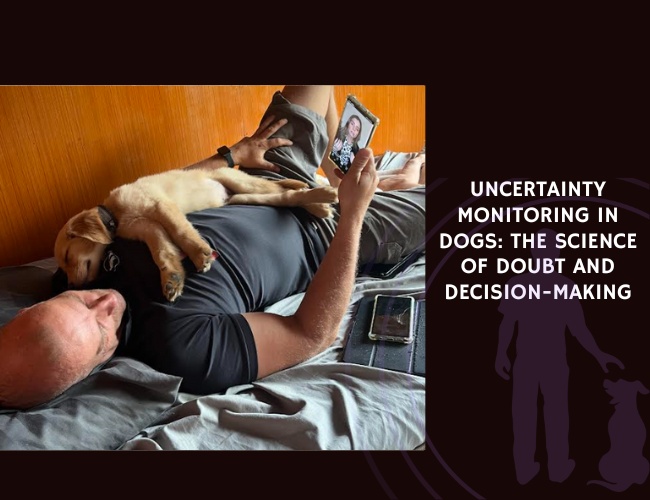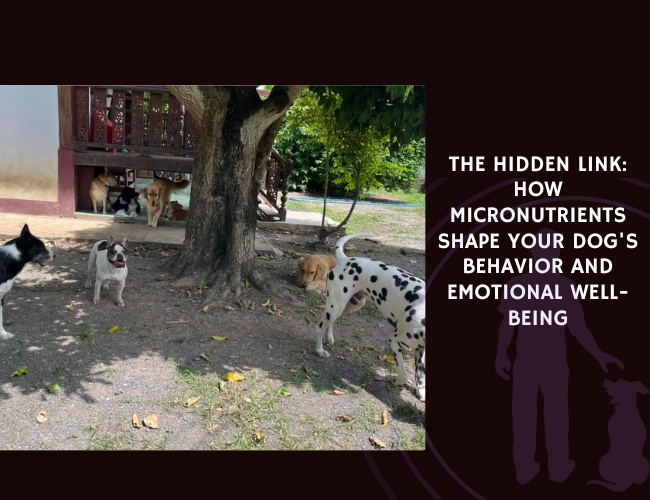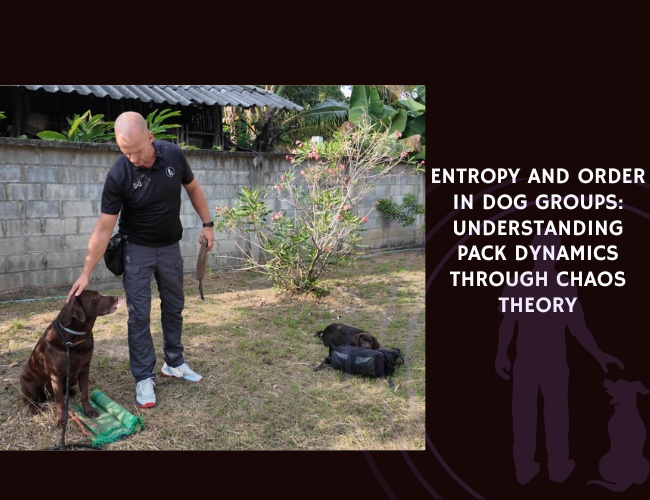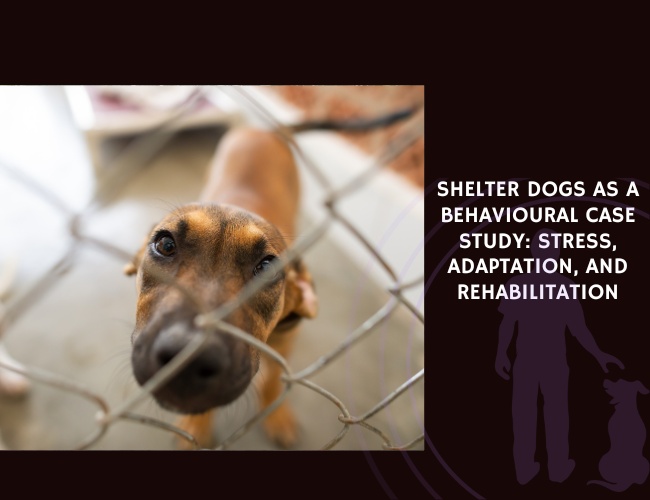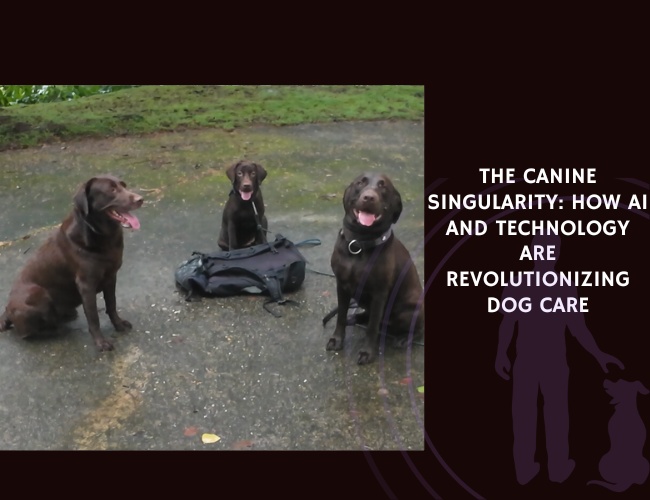Introduction: When Your Dog Hesitates at the Door
Have you ever watched your dog pause at the threshold of an open door, sniffing the air, ears rotating, perhaps taking a step back before finally deciding whether to venture outside? That moment of hesitation isn’t just simple indecision—it’s a window into your dog’s remarkable cognitive world, where doubt, assessment, and decision-making converge in ways that mirror our own mental processes far more than we once imagined.
For decades, scientists believed that uncertainty monitoring—the ability to recognize and respond to one’s own doubt—was uniquely human, perhaps shared only with our closest primate relatives. But groundbreaking research is revealing that our canine companions possess sophisticated metacognitive abilities, allowing them to assess what they know, recognize what they don’t know, and adjust their behavior accordingly. This capacity for self-reflection transforms how we understand canine intelligence and has profound implications for training, welfare, and the human-dog bond.
Let us guide you through the fascinating science of how dogs experience and express uncertainty, from the neural circuits firing in their brains to the subtle body language signals you might notice during your next training session. Understanding these processes doesn’t just satisfy scientific curiosity—it offers practical tools for creating more compassionate, effective approaches to living and working with our four-legged friends.
Understanding Canine Hesitation Behaviors
The Language of Doubt: Reading Your Dog’s Uncertainty Signals
When your dog experiences uncertainty, their body becomes a canvas of subtle communication that tells a rich story about their internal state. These hesitation behaviors aren’t random quirks but rather evolved responses that help dogs navigate ambiguous situations while maintaining social harmony.
Primary displacement behaviors manifest when dogs face conflicting motivations or unclear contexts. You might notice your usually confident retriever suddenly becoming fascinated with sniffing the ground when asked to perform a new command, or your Border Collie yawning repeatedly during a challenging agility sequence. These aren’t signs of disinterest—they’re sophisticated coping mechanisms that buy time for cognitive processing.
Research has identified a constellation of uncertainty indicators that appear more frequently in ambiguous contexts than in clearly threatening or safe situations. Lip-wiping, that subtle swipe from the mouth’s midpoint to the corner, emerges particularly when dogs struggle to predict a social partner’s behavior. Nose-licking, distinct from the normal moistening licks, increases when environmental cues conflict. Even the position of your dog’s ears tells a story—forward-facing ears suggest active threat assessment, while rotated ears often indicate processing of neutral but confusing information.
The multi-modal nature of uncertainty expression means dogs often combine several signals simultaneously. A dog uncertain about approaching a novel object might exhibit a characteristic pattern: approaching with a lowered body posture, frequent glances back at their human, intermittent sniffing of seemingly random spots, and perhaps a play bow that never quite develops into actual play. This behavioral clustering helps dogs manage their emotional state while gathering additional information.
Environmental Triggers: When Ambiguity Strikes
Not all uncertainty is created equal in the canine world. Different contexts elicit distinct patterns of hesitation, and understanding these patterns helps us support our dogs through challenging moments.
Social ambiguity presents unique challenges because dogs, as highly social animals, have evolved to read and respond to social cues with remarkable precision. When these cues become unclear—perhaps a usually friendly neighbor appears wearing unusual clothing, or a familiar dog displays conflicting body language—dogs must navigate complex decision trees. Studies using video stimuli have shown that dogs look significantly longer at threatening videos, but show more displacement behaviors when viewing neutral, ambiguous social scenes where behavioral predictions become difficult.
Environmental uncertainty emerges when familiar spaces change or when dogs encounter novel situations without clear precedent. That hesitation at the veterinary clinic door isn’t just reluctance—it’s active processing of conflicting information: familiar car ride protocols suggesting safety versus olfactory memories of previous medical experiences suggesting caution. Similarly, a dog encountering a robotic vacuum for the first time must categorize this moving, noisy object that defies easy classification as animate or inanimate, threat or tool.
Task-related doubt appears frequently in training contexts when instructions become unclear or when previously reliable patterns suddenly change. The phenomenon of perseverative errors—when dogs continue searching in previously rewarded locations even after the reward has moved—demonstrates how uncertainty can trigger reliance on established patterns even when current evidence suggests change. This isn’t stubbornness but rather a cognitive strategy for managing ambiguity. 🧠
The Cognitive Architecture of Canine Doubt
Metacognition in Dogs: Thinking About Thinking
The discovery that dogs possess metacognitive abilities—the capacity to reflect on their own mental states—revolutionizes our understanding of canine consciousness. This isn’t merely responding to external stimuli; it’s an internal monitoring system that evaluates confidence levels and adjusts behavior accordingly.
The opt-out paradigm has become the gold standard for demonstrating metacognition across species. When dogs are given the choice between attempting a difficult discrimination task or choosing a safe “bail-out” option with a smaller but guaranteed reward, their choices reveal sophisticated self-awareness. Dogs consistently opt out more frequently when task difficulty increases or when sensory information becomes degraded, suggesting they can assess their own likelihood of success.
Meta-analyses examining uncertainty monitoring across non-primate species, including extensive data from pigeons, rats, large-billed crows, and bees, show significantly positive effect sizes for metacognitive abilities. Dogs, with their complex social cognition and extensive co-evolution with humans, demonstrate these capabilities with particular sophistication. They don’t just avoid difficult tasks randomly—they show systematic patterns that correlate with objective task difficulty and their individual learning history.
Information-seeking behaviors provide another window into canine metacognition. When uncertain, dogs actively gather additional data through exploratory sniffing, visual scanning, and social referencing (looking to humans for cues). This isn’t passive confusion but active problem-solving, suggesting dogs maintain internal representations of their knowledge states and work strategically to fill gaps.
Adaptive Value vs. Learned Responses
The question of whether hesitation represents genuine metacognitive awareness or simply conditioned responses has profound implications for how we understand and interact with dogs. Current evidence suggests a nuanced answer: both processes contribute, but in different ways and contexts.
Adaptive uncertainty monitoring offers clear evolutionary advantages. Dogs that could accurately assess their confidence levels would make better decisions about when to pursue prey, when to engage in conflicts, and when to seek additional information. This adaptive value extends to modern contexts—a service dog that recognizes its own uncertainty about a handler’s medical state can alert earlier and more reliably than one responding only to fixed cues.
The neural evidence supports genuine metacognitive processing. Brain regions associated with uncertainty monitoring in humans and primates, particularly the prefrontal cortex and anterior cingulate cortex, show homologous activation patterns in dogs during decision-making tasks. This suggests conserved neural mechanisms for doubt and confidence assessment across mammalian species.
Learned components certainly influence uncertainty expression, but they operate within the metacognitive framework rather than replacing it. A dog’s specific hesitation behaviors might be shaped by reinforcement history—one dog might learn that sniffing delays unwanted tasks, while another discovers that sitting and looking at their owner generates helpful information. But the underlying capacity to recognize uncertainty and the drive to resolve it appears innate.
Context-Dependent Decision Making
The expression and resolution of uncertainty varies dramatically between problem-solving and social contexts, revealing the sophisticated cognitive flexibility dogs bring to different challenges.
Problem-solving uncertainty typically involves interactions with the physical environment and tends to follow predictable patterns. Dogs facing a puzzle feeder they can’t immediately solve might cycle through previously successful strategies, show increased exploration of the device’s features, and eventually either persist with modified approaches or disengage entirely. The decision to continue or quit correlates with factors like past success rates, current motivation levels, and available alternatives.
Social uncertainty engages additional cognitive systems because social errors carry different consequences than physical mistakes. A dog uncertain about another dog’s intentions must weigh not just immediate outcomes but also relationship implications and group dynamics. This social calculus explains why dogs show more subtle, varied displacement behaviors in social ambiguity compared to the more direct trial-and-error approaches seen in non-social problem-solving.
The integration of contextual information reveals remarkable sophistication. Dogs don’t just respond to immediate uncertainty—they factor in environmental context, past experiences, current physiological state, and social dynamics to generate adaptive responses. This multi-factor decision-making mirrors human cognitive processes more closely than previously recognized. 🐾

The Neurobiology of Doubt and Decision-Making
Brain Networks: The Neural Orchestra of Uncertainty
Understanding how the canine brain processes uncertainty reveals fascinating parallels with human neurobiology while highlighting unique adaptations shaped by domestication and co-evolution with humans.
The prefrontal cortex (PFC) serves as the executive control center for uncertainty processing in dogs, much as it does in humans and other primates. This brain region, particularly developed in dogs compared to their wolf ancestors, orchestrates the complex cognitive operations required for metacognitive awareness. When your dog pauses to assess a situation, the PFC integrates sensory information, retrieves relevant memories, and generates predictions about potential outcomes.
The dorsomedial prefrontal cortex and dorsal anterior cingulate cortex (dmPFC/dACC) work in concert to detect and resolve cognitive conflict—those moments when multiple possible actions compete for expression. Functional imaging studies in related species suggest these regions become particularly active when dogs face ambiguous stimuli that could be interpreted multiple ways. This neural signature of uncertainty processing helps explain why some dogs seem to “think harder” in challenging situations, showing visible signs of concentration.
The anterior cingulate cortex (ACC) plays a crucial role in monitoring for conflicts between expectations and reality. When your dog expects a treat after performing a trick but receives praise instead, the ACC signals this prediction error, triggering behavioral adjustments and learning. This region’s sensitivity to uncertainty helps dogs adapt their behavior in real-time, switching strategies when current approaches aren’t yielding expected results.
The orbitofrontal cortex (OFC) contributes by evaluating the emotional significance of uncertain situations. Is this ambiguous situation potentially rewarding or threatening? The OFC helps assign affective value to uncertain outcomes, influencing whether a dog approaches or avoids ambiguous stimuli. Dogs with damage to this region often show impaired decision-making in uncertain contexts, either becoming overly reckless or excessively cautious.
Neurochemical Modulation: The Molecular Basis of Confidence
The dance of neurotransmitters in the canine brain creates the subjective experience of confidence or doubt, influencing how dogs navigate uncertain situations.
Dopamine systems regulate reward prediction and motivation during uncertainty. When dogs face ambiguous situations with potential rewards, dopamine neurons fire in complex patterns that encode both the expected value and the uncertainty around that expectation. Higher uncertainty typically correlates with increased dopamine system activation, preparing the dog for flexible behavioral responses. This explains why some dogs become visibly excited when facing novel challenges—their dopamine systems are priming them for potential discovery and reward.
Serotonin modulates patience and impulse control when dealing with uncertainty. Dogs with healthy serotonin function can maintain behavioral inhibition longer when uncertain, gathering more information before acting. This neurotransmitter particularly influences how dogs handle delayed or ambiguous rewards. Research on the effects of medications affecting serotonin in dogs shows clear impacts on decision-making under uncertainty, with optimal levels supporting balanced, thoughtful responses to ambiguous situations.
Noradrenaline acts as an uncertainty alarm system, heightening attention and arousal when confidence drops. This neurotransmitter helps dogs maintain vigilance in ambiguous situations, ensuring they don’t miss important environmental changes. The interplay between noradrenaline and stress hormones like cortisol can influence whether uncertainty triggers adaptive caution or problematic anxiety.
The complex interconnection between these neurotransmitter systems and sex hormones adds another layer of complexity. Studies on neutering effects reveal how hormonal changes can alter the balance of these neurotransmitter systems, potentially affecting a dog’s tolerance for uncertainty and tendency toward anxiety in ambiguous situations. 🧠
Measuring the Unmeasurable: Brain Imaging in Conscious Dogs
Recent advances in non-invasive brain imaging are opening unprecedented windows into canine cognition, allowing researchers to observe uncertainty processing in real-time.
Functional Near-Infrared Spectroscopy (fNIRS) represents a breakthrough for studying awake, behaving dogs. This technology measures blood oxygenation changes in the brain, providing insights into which regions activate during uncertainty. Unlike traditional fMRI, which requires complete stillness, fNIRS allows dogs to move relatively freely, making it possible to study natural behaviors. Researchers have successfully used fNIRS to identify distinct patterns of prefrontal activation when dogs face easy versus difficult discriminations, with uncertainty correlating with increased activation in specific PFC subregions.
Electroencephalography (EEG) adapted for dogs reveals the temporal dynamics of uncertainty processing. Special non-invasive sensors can detect the electrical signatures of doubt and decision-making, showing characteristic patterns like increased theta wave activity in frontal regions during uncertain decisions. These “uncertainty signatures” appear remarkably similar to those seen in humans facing ambiguous choices, suggesting conserved neural mechanisms across species.
Magnetoencephalography (MEG) applications, though still experimental in dogs, promise even greater insights. This technology can capture the magnetic fields generated by neural activity with millisecond precision, potentially revealing the exact sequence of brain events from uncertainty detection to behavioral response. Pilot studies suggest dogs show a characteristic sequence: early sensory processing, uncertainty detection around 200-300 milliseconds, followed by response preparation that varies based on confidence levels.
Curious. Hesitant. Reflective.
Doubt is communication. Every pause, yawn, or lip-lick is your dog’s way of signaling internal conflict. These subtle cues aren’t mistakes—they’re evolved strategies for navigating uncertainty with care.
Context shapes hesitation. Social ambiguity, shifting environments, and unclear tasks each trigger unique patterns of doubt. What looks like reluctance is often active processing of competing signals.

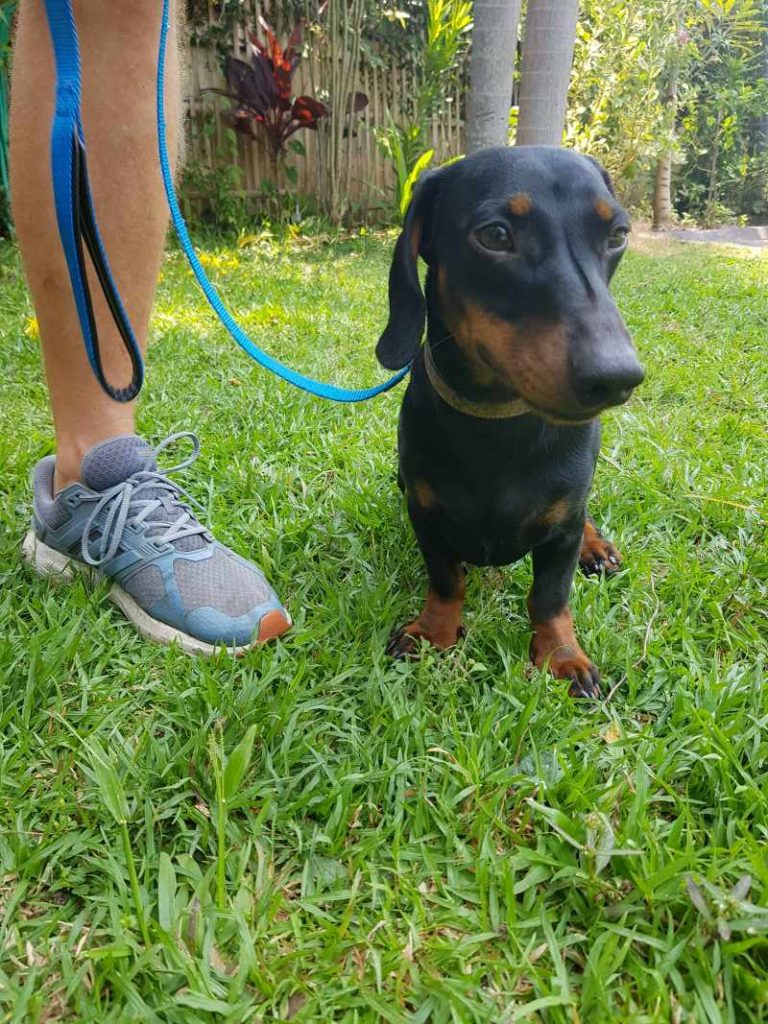
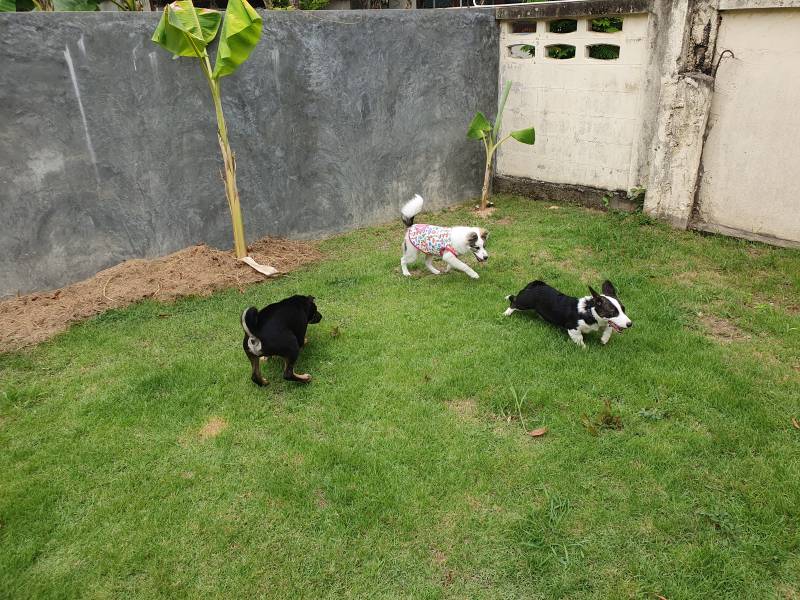
Uncertainty builds resilience. By recognizing and respecting these signals, you transform hesitation into trust. Supporting your dog’s decision-making deepens connection and fosters confident, adaptive behavior.
Environmental and Individual Influences on Uncertainty Processing
The Past Shapes the Present: Experience and Uncertainty Tolerance
Every dog’s history creates a unique lens through which they view and respond to ambiguous situations, with profound implications for their welfare and training.
Early developmental experiences set the foundation for uncertainty tolerance. Puppies exposed to varied, manageable challenges during critical socialization periods develop more robust uncertainty monitoring systems. These dogs show more adaptive displacement behaviors, better information-seeking strategies, and quicker recovery from uncertain situations. Conversely, puppies with limited early experiences or traumatic events may develop hypersensitivity to ambiguity, showing excessive displacement behaviors or avoiding uncertain situations entirely.
Training history profoundly influences how dogs express and resolve uncertainty. Dogs trained with clear, consistent methods develop confidence in their ability to navigate ambiguity. They learn that uncertainty is temporary and resolvable through appropriate information-seeking or behavioral adjustment. In contrast, dogs subjected to unpredictable or punishment-based training may develop maladaptive responses to uncertainty, including learned helplessness or excessive anxiety when facing ambiguous situations.
Warning Signs of Problematic Training History:
- Learned helplessness – Shuts down or becomes passive when facing any uncertainty
- Excessive displacement behaviors – Shows multiple, escalating uncertainty signals in mildly ambiguous situations
- Avoidance patterns – Consistently chooses to disengage rather than attempt resolution
- Hypervigilance – Constantly scanning for potential uncertainties, unable to relax
- Delayed recovery – Takes extended time (5+ minutes) to return to baseline after uncertain encounters
- Generalized anxiety – Shows stress signals in situations that shouldn’t trigger uncertainty
The concept of cognitive enrichment extends beyond simple environmental complexity. Dogs regularly presented with novel problems to solve, varied social interactions, and opportunities for choice develop more sophisticated uncertainty monitoring abilities. These enriched dogs show more nuanced displacement behaviors, better discrimination between genuinely threatening and merely ambiguous situations, and more creative problem-solving approaches when uncertain.
Trauma and uncertainty intolerance represent a critical welfare concern. Dogs that have experienced significant trauma often show altered uncertainty processing, with research indicating changes in amygdala sensitivity and prefrontal regulation. These dogs might interpret ambiguous situations as threatening by default, showing excessive stress responses to normal environmental variability. Understanding this connection helps explain why traumatized dogs often struggle with changes in routine or novel situations that other dogs navigate easily. 🧡
Individual Differences: Breed, Age, and Temperament Factors
Not all dogs process uncertainty equally, and recognizing these individual differences is crucial for tailored training and welfare approaches.
Breed-specific tendencies reflect centuries of selective breeding for different behavioral traits. Herding breeds like Border Collies and Australian Shepherds, bred for independent decision-making in ambiguous situations, often show high tolerance for uncertainty and sophisticated information-seeking behaviors. They might spend longer assessing ambiguous situations but make more accurate decisions once they act. Conversely, breeds selected for immediate response to human cues, like many toy breeds, might show quicker but less independent resolution of uncertainty, relying more heavily on social referencing.
Age-related changes in uncertainty processing follow predictable developmental patterns. Young puppies show limited uncertainty monitoring, often acting impulsively without apparent doubt. Adolescent dogs (6-18 months) begin developing metacognitive abilities but may struggle with impulse control when uncertain, leading to seemingly erratic behavior. Adult dogs (2-7 years) typically show peak uncertainty monitoring abilities, with balanced assessment and response to ambiguous situations. Senior dogs may show increased hesitation, not necessarily from cognitive decline but from accumulated experience teaching them that careful assessment prevents errors.
Temperament dimensions create individual uncertainty profiles independent of breed or age. The Canine Frustration Questionnaire reveals how frustration tolerance—closely linked to uncertainty tolerance—varies dramatically between individuals. Dogs high in neuroticism show stronger physiological responses to uncertainty, more displacement behaviors, and longer recovery times after ambiguous encounters. Those high in openness might actively seek uncertain situations, showing excitement rather than anxiety when facing ambiguity.
The interaction between sex and hormonal status adds another layer of complexity. Intact males might show different uncertainty responses around resource competition compared to neutered males, while females may show cyclic changes in uncertainty tolerance correlating with reproductive hormones. These biological influences interact with experience and training to create each dog’s unique uncertainty profile.
The Human Factor: How We Shape Canine Responses to Doubt
The human-dog relationship profoundly influences how dogs experience and express uncertainty, with our responses either supporting or undermining their cognitive development.
Communication clarity directly impacts canine uncertainty levels. Clear, consistent cues reduce unnecessary ambiguity, allowing dogs to reserve their uncertainty processing for genuinely ambiguous situations. When humans provide mixed signals—saying “come” while displaying closed body language, for instance—dogs must navigate not just task uncertainty but also social confusion. Research in ostensive-communicative contexts shows dogs are exquisitely sensitive to human communicative intent, and unclear human signals create cascading uncertainty effects.
Encouragement and support during uncertain moments shape future responses. When owners respond to their dog’s hesitation with patience and gentle guidance, dogs learn that uncertainty is manageable and temporary. They develop confidence in their ability to work through ambiguous situations. Conversely, punishment for hesitation or forcing dogs through uncertain situations without support can create anxiety associations with uncertainty itself, leading to escalating displacement behaviors and avoidance.
The phenomenon of social referencing reveals how deeply dogs rely on human emotional cues when uncertain. Dogs actively look to their owners when facing ambiguous stimuli, using human emotional expressions to calibrate their own responses. An owner’s calm confidence when their dog hesitates at a novel object can facilitate approach and investigation, while anxious or frustrated human responses amplify canine uncertainty. This bi-directional emotional influence means that helping dogs manage uncertainty often requires humans to manage their own emotional responses first.
Timing and type of intervention matter enormously. Premature rescue from uncertain situations prevents dogs from developing their own uncertainty resolution skills, potentially creating learned helplessness. Conversely, allowing dogs to struggle excessively without support can create negative associations with challenge and exploration. The sweet spot involves recognizing when a dog is productively working through uncertainty versus when they’re becoming overwhelmed, intervening with just enough support to maintain forward progress without eliminating the learning opportunity. 🐾

Applications to Training and Welfare
Revolutionary Training: Embracing Uncertainty as a Tool
Understanding uncertainty monitoring transforms dog training from a series of commands and responses into a collaborative learning process that respects canine cognition.
Recognizing productive uncertainty versus overwhelming confusion becomes a core training skill. Productive uncertainty appears as focused attention, information-seeking behaviors, and trial-and-error attempts with recovery between trials. The dog remains engaged, showing displacement behaviors that serve as brief “thinking breaks” rather than stress signals. Overwhelming confusion manifests as escalating displacement behaviors, disengagement, or stress signals like excessive panting or attempts to leave the training area.
Signs of Productive Uncertainty (Good Learning Zone):
- Brief displacement behaviors – Quick lip-lick or ground sniff followed by re-engagement with task
- Alternating strategies – Tries different approaches systematically rather than random behavior
- Checking in with handler – Quick glances for information while maintaining task focus
- Body tension changes – Momentary stiffening followed by relaxation as they work through the problem
- Thoughtful pauses – Stopping to assess before trying again, not freezing in stress
- Partial attempts – Starting behaviors even if not completing them perfectly
Signs of Overwhelming Confusion (Need Support):
- Displacement behavior chains – Multiple signals in succession (yawn, scratch, sniff, shake-off)
- Complete disengagement – Turning away from task and handler, attempting to leave area
- Stress escalation – Panting, drooling, dilated pupils, trembling
- Repetitive behaviors – Stuck in loops of the same unsuccessful attempt
- Shutdown – Lying down, becoming immobile, refusing to attempt anything
- Redirected behaviors – Suddenly interested in everything except the task at hand
Graduated challenge approaches leverage uncertainty monitoring for optimal learning. Rather than avoiding all ambiguity or throwing dogs into confusing situations, effective training creates manageable uncertainty that dogs can resolve with effort. This might involve gradually increasing the difficulty of discriminations, adding mild distractions to known behaviors, or introducing novel variations of familiar tasks. Each successful resolution of uncertainty builds confidence and metacognitive skill.
The power of pause recognizes hesitation as cognitive processing rather than defiance. When a dog hesitates before responding to a cue, they might be weighing multiple possible responses, assessing confidence levels, or seeking additional information. Allowing this processing time, rather than repeating commands or showing frustration, often results in more accurate responses and deeper learning. Some progressive trainers now explicitly teach a “think about it” cue, encouraging dogs to take time when uncertain rather than guessing.
The integration of choice-based training specifically supports uncertainty monitoring development. Offering dogs options—which toy to retrieve, which path to take, which trick to perform for a reward—requires them to assess their own preferences and confidence levels. This regular practice with low-stakes uncertainty builds skills that transfer to more challenging situations. Dogs trained with choice-based methods show better problem-solving abilities and more adaptive responses to novel situations.
The Opt-Out Revolution: Supporting Autonomy and Confidence
Allowing dogs to communicate uncertainty and choose disengagement represents a paradigm shift in training and welfare philosophy.
Formal opt-out protocols in training give dogs explicit ways to communicate “I don’t understand” or “I need a break.” This might involve teaching a specific signal like sitting and looking away, moving to a designated mat, or touching a particular target to request easier tasks or breaks. Dogs with access to opt-out options show reduced stress during training, faster learning of complex behaviors, and stronger working relationships with their handlers.
Natural opt-out recognition involves respecting the subtle signals dogs already use to communicate uncertainty or discomfort. When a dog offers displacement behaviors, breaks eye contact, or moves away slightly, acknowledging these as valid communication rather than problems to fix creates a more collaborative training environment. This approach particularly benefits sensitive dogs or those with trauma histories who may have learned that their communications are ignored.
The welfare implications extend beyond training into daily life. Environmental opt-outs might include safe spaces dogs can retreat to when overwhelmed, the ability to choose whether to greet visitors, or options to avoid or approach novel stimuli at their own pace. Service dog programs increasingly recognize that dogs who can communicate uncertainty about their ability to work on a given day are more reliable long-term than those pushed to work regardless of their internal state.
Research on the psychological empowerment effects shows that dogs with opt-out options develop greater confidence over time. They become more willing to attempt challenging tasks because they know they can communicate if overwhelmed. This paradoxically leads to less frequent use of opt-out behaviors as dogs develop stronger uncertainty tolerance through positive experiences with manageable challenges. 🧡
Welfare Assessment: A New Lens for Understanding Canine Well-being
Incorporating uncertainty monitoring into welfare assessments provides more nuanced, accurate evaluations of dog well-being across various contexts.
Shelter assessments benefit enormously from understanding uncertainty signals. Traditional temperament tests often misinterpret displacement behaviors as disinterest or aggression, potentially leading to incorrect placement decisions or euthanasia. Recognizing that a dog showing lip-licking, yawning, and ground-sniffing during assessment is processing uncertainty rather than showing problematic behavior changes the entire evaluation framework. Progressive shelters now include “uncertainty tolerance” as an explicit assessment category, noting how dogs handle ambiguous situations and what support they need to succeed.
Service dog selection and training increasingly emphasizes uncertainty monitoring abilities. The best service dogs aren’t those who never experience doubt but those who can recognize uncertainty, seek appropriate information, and make good decisions even when confidence isn’t absolute. Programs now specifically test for metacognitive abilities, looking for dogs who show appropriate hesitation when uncertain but can work through ambiguity with support. This selection criterion has improved program success rates and handler satisfaction.
For research settings, understanding uncertainty monitoring raises important ethical considerations. Progressive research protocols now include:
- Pre-study welfare assessments – Evaluating each dog’s baseline uncertainty tolerance before enrollment
- Continuous monitoring protocols – Real-time tracking of displacement behaviors to identify when cognitive challenge becomes distress
- Graduated opt-out systems – Multiple levels of disengagement options, from brief pauses to complete withdrawal from studies
- Recovery requirements – Mandatory rest periods after high-uncertainty tasks to prevent cognitive fatigue
- Individual threshold mapping – Documenting each dog’s uncertainty signals to personalize research protocols
- Positive welfare indicators – Ensuring dogs show play behaviors, relaxed body language, and voluntary re-engagement between trials
Studies must distinguish between productive cognitive challenge and distressing confusion, ensuring that research protocols respect dogs’ cognitive capabilities while maintaining welfare standards. Some research facilities now require demonstration that dogs can successfully use opt-out options before they participate in studies.
The Canine Frustration Questionnaire and similar tools provide objective welfare metrics that capture uncertainty-related distress. Regular assessment using these tools can identify dogs struggling with environmental unpredictability, training inconsistency, or cognitive challenges beyond their current capabilities. This data-driven approach to welfare moves beyond subjective impressions to evidence-based intervention.
Practical Implementation: Supporting Your Dog Through Uncertainty
Daily Life Applications: Recognizing and Responding to Doubt
Understanding uncertainty monitoring transforms everyday interactions with your dog from potential sources of confusion into opportunities for growth and bonding.
Morning routine variations offer perfect low-stakes uncertainty practice. Instead of rigid schedules, introducing small, manageable variations—taking a different route on walks, changing the order of morning activities, or offering choice between two breakfast locations—helps dogs develop flexibility. Watch for those telling displacement behaviors: a brief ground sniff before choosing a path, a quick lip-lick before approaching their food bowl in a new location. These aren’t problems but healthy cognitive processing that builds resilience.
Novel object introductions become teachable moments when viewed through the uncertainty lens. When your dog encounters something new—a package on the doorstep, a piece of furniture moved, a new toy—their hesitation behaviors tell you exactly what support they need. Rapid displacement behaviors suggest overwhelming uncertainty requiring your calm presence and gradual approach. Intermittent sniffing with forward body posture indicates productive investigation that needs time, not intervention.
Social situation navigation requires particular sensitivity to uncertainty signals. Dog parks, veterinary visits, and meeting new people all present ambiguous social contexts. Your dog’s ear position, frequency of looking to you for information, and type of displacement behaviors indicate their confidence level. Supporting them might mean allowing extra sniffing time before entering the dog park, providing treats during veterinary examinations to create positive associations, or letting them choose their approach distance to new people.
The key lies in reading the full picture: not just individual behaviors but patterns, contexts, and changes over time. A dog who typically shows minimal displacement behaviors suddenly increasing lip-licking and yawning needs investigation—what’s changed in their environment creating new uncertainty? Conversely, a naturally cautious dog showing fewer displacement behaviors over time in familiar situations indicates growing confidence that should be celebrated.
Building Uncertainty Tolerance: A Progressive Approach
Developing your dog’s ability to handle uncertainty follows predictable stages, each building on previous successes.
Foundation stage focuses on creating safety and predictability in core routines while introducing controlled variations. Start with your dog’s strongest behaviors—perhaps sit or down—and add minor variations: asking for the behavior in slightly different locations, with you in different positions, or with mild distractions present. Success here means your dog shows brief hesitation (a momentary ear rotation, quick glance around) but then performs the behavior. Reward both the behavior and the cognitive work of processing uncertainty.
Expansion stage introduces novel challenges within supportive frameworks. Puzzle feeders represent perfect uncertainty training tools—dogs must experiment with different strategies, experience temporary frustration, and discover solutions. Start with simple puzzles, allowing sniffing, pawing, and other exploratory behaviors without intervention. Graduate to more complex challenges as your dog’s displacement behaviors decrease and solution-finding accelerates. The goal isn’t speed but developing systematic approach strategies when facing uncertainty.
Integration stage brings uncertainty tolerance into real-world contexts. This might involve visiting novel environments, meeting unfamiliar dogs with different play styles, or encountering unusual stimuli during walks. Your role shifts from direct guidance to emotional support—being a calm, confident presence while your dog processes ambiguous situations. Celebrate moments when your dog shows appropriate caution, investigates systematically, and makes independent decisions about approach or avoidance.
Mastery indicators include decreased latency between uncertainty detection and resolution, more efficient information-seeking behaviors, and quicker recovery after ambiguous encounters. Dogs at this stage might still show displacement behaviors, but they’re brief and purposeful—a quick ground sniff to buy thinking time rather than prolonged avoidance. They develop preferred uncertainty resolution strategies and apply them flexibly across contexts. 🐾
Future Directions and Emerging Understanding
The Science on the Horizon
The field of canine uncertainty monitoring stands at an exciting threshold, with emerging technologies and theoretical frameworks promising deeper insights into how dogs experience and navigate doubt.
Artificial intelligence integration in behavior analysis will revolutionize our ability to detect and interpret subtle uncertainty signals. Machine learning algorithms trained on thousands of hours of video data will identify displacement behavior patterns invisible to human observers, potentially revealing new categories of uncertainty expression and individual variation in doubt signaling. This technology won’t replace human observation but will augment it, helping trainers and veterinarians recognize welfare concerns earlier and more accurately.
Genetic and epigenetic research promises to uncover the biological basis of uncertainty tolerance variations. Early studies suggest specific gene variants influence neurotransmitter systems involved in uncertainty processing, potentially explaining why some breeds and individuals show greater resilience to ambiguity. Understanding these biological underpinnings won’t justify genetic determinism but will help tailor support strategies to individual dogs’ neurobiological profiles.
Cross-species comparative studies will clarify which aspects of uncertainty monitoring are uniquely canine versus broadly mammalian. Comparing dogs with wolves reveals how domestication shaped uncertainty processing, while comparisons with cats, horses, and other domestic species illuminate how different evolutionary pressures created diverse uncertainty monitoring strategies. These insights will refine our understanding of what makes the dog-human relationship special while identifying universal principles applicable across species.
Implications for the Human-Canine Bond
Understanding uncertainty monitoring fundamentally reframes the dog-human relationship from one of command and obedience to one of communication and collaboration.
Emotional attunement becomes bidirectional when we recognize dogs’ uncertainty signals. Just as dogs use social referencing to gauge our emotional states when uncertain, we can learn to read their doubt and respond supportively. This mutual emotional awareness creates deeper bonds built on genuine understanding rather than mere conditioning. Families who learn to recognize and respect their dog’s uncertainty signals report stronger relationships and fewer behavioral problems.
Cognitive respect emerges from acknowledging dogs’ metacognitive abilities. When we understand that hesitation represents complex cognitive processing rather than simple confusion or defiance, we naturally adopt more patient, supportive training approaches. This shift from viewing dogs as stimulus-response machines to recognizing them as thinking beings with internal mental states transforms not just training methods but the entire framework of human-dog interaction.
The concept of collaborative problem-solving replaces traditional dominance-based paradigms. When facing challenges—whether a dog fearful of thunderstorms or one struggling with separation anxiety—the focus shifts from imposing solutions to working together through uncertainty. The human provides structure and support while respecting the dog’s need to process and resolve ambiguity at their own pace. This collaborative approach yields more sustainable behavioral change and stronger relationships.
Conclusion: Is Uncertainty Monitoring Awareness Right for Your Training Approach?
As we’ve explored throughout this comprehensive guide, understanding how your dog experiences and expresses uncertainty isn’t just an academic exercise—it’s a practical tool that can transform your relationship with your canine companion. The science reveals that our dogs possess remarkable cognitive abilities, capable of recognizing their own doubt, seeking information to resolve ambiguity, and making sophisticated decisions under uncertain conditions.
Consider how this knowledge might change your daily interactions. That moment of hesitation before your dog enters the veterinary clinic becomes an opportunity for support rather than frustration. The displacement behaviors during training signal productive cognitive processing rather than defiance. The choice to opt-out of an overwhelming situation demonstrates wisdom rather than weakness. Each of these reframes strengthens the trust and communication between you and your dog.
For those working professionally with dogs—trainers, veterinarians, shelter workers, and service dog handlers—integrating uncertainty monitoring awareness offers evidence-based approaches to improving welfare and outcomes. Recognizing displacement behaviors as uncertainty signals rather than stress or aggression changes assessment protocols. Providing opt-out options empowers dogs while paradoxically increasing their confidence and willingness to engage. Understanding individual differences in uncertainty tolerance allows for tailored support strategies that respect each dog’s unique cognitive profile.
The journey toward understanding canine uncertainty monitoring has only just begun. As research continues revealing the depth of dogs’ cognitive abilities, our responsibility grows to apply this knowledge compassionately and effectively. Whether you’re teaching a puppy their first commands, helping a rescue dog overcome past trauma, or simply navigating daily life with your faithful companion, recognizing and respecting their uncertainty creates opportunities for growth, learning, and deeper connection.
Next time you see your dog pause, sniff, or glance your way when facing something new or ambiguous, remember—you’re witnessing a sophisticated mind at work, processing information, weighing options, and making decisions. By supporting them through these moments of doubt with patience, understanding, and appropriate guidance, you’re not just training a behavior; you’re nurturing a thinking, feeling being capable of remarkable cognitive feats. And in doing so, you’re strengthening a bond that transcends simple obedience to become true interspecies understanding and collaboration. 🧡

